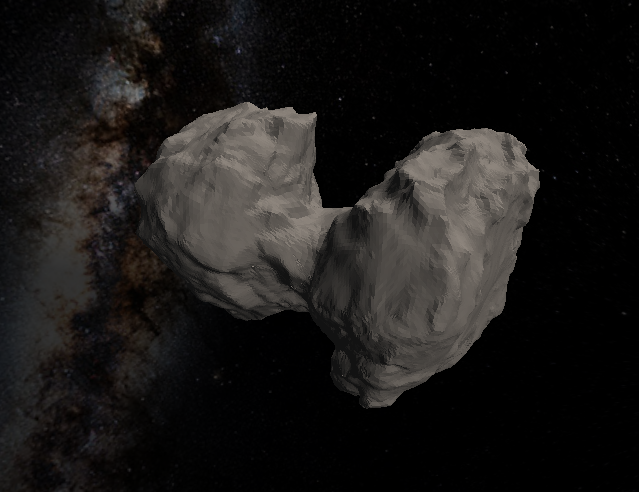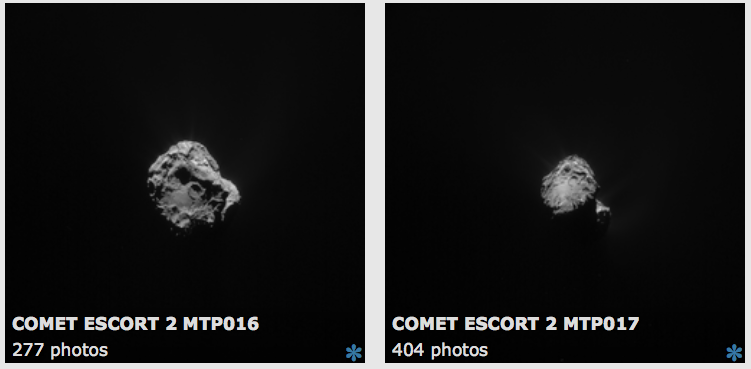A new 3D shape model of Comet 67P/Churyumov-Gerasimenko has been released by ESA’s Rosetta archive team today. The model includes images taken by Rosetta’s NAVCAM up until mid-late July 2015, and reveals parts of the comet’s southern hemisphere that were not included in earlier shape models.

The updated shape model now includes recent images of the comet’s southern hemisphere. Click to explore and for download options. Credit: ESA/Rosetta/NAVCAM, CC BY-SA IGO 3.0
The release also includes .WRL, OBJ, STL files, which can be used for 3D printing.
At the same time, 681 images have been added to the Archive Image Browser covering the period 6 May to 30 June 2015 as part of ESA’s regular monthly release of NAVCAM images.
During this period the comet was heading towards perihelion on 13 August, the closest point to the Sun along its orbit, and so the images capture some details of the comet’s increasing activity.

Caption: The latest Archive Image Browser release. Click to enter browser. All images: ESA/Rosetta/NAVCAM, CC BY-SA IGO 3.0.
Taking into account the upcoming seasonal holiday, the next NAVCAM archive release will be made early-mid January 2016.
For background information on what a shape model is, read our blog post: A shape model – what’s that?
We hope you enjoy using the updated shape model – do let us know if you’ve used it for your own projects, or if you have any questions about it, by writing in the comment box below.
The model is licensed under a Creative Commons Attribution-ShareAlike 3.0 IGO License.









Discussion: 21 comments
Humbly asking ESA and Mattias to generate rotating videos on 3 axis.
Logan,
as an intermediate solution,
you may follow the link
https://imagearchives.esac.esa.int/index.php?/page/navcam_3d_models
as provided in the blog post,
move the mouse pointer onto the comet, then keep the left mouse button pressed, and drag the mouse.
The comet rotates according to your drag (it should, at least).
My work processor is not up to the task. Will try downloading vrml plug-in at home 🙂
Mattias made some videos for Dr. Parker, not as up to date as these brought to the table by Emily.
https://mattias.malmer.nu/2015/03/360-spins-for-joel-parker/
Mattias latest 3D model has more texture.
Nothing beats actually getting a 3 D printed version in your hands. Matt Malmers models seems best to capture the textural details.
Incidentally, taking a photo of the 3D printed model at the right angle can really make obvious the large scale matches:
https://largescalematches67p.blogspot.com.au/
I have updated the post which outlines the case to look for small scale matches when the large scale matches extend all the way around, and are fairly obvious. I would definitely thank Gerald for the suggestions of picking images which show the matches more obviously and for getting textural details on the models. It appears the only way to communicate to the general mission scientist, or the general public for that matter.
There is as least once shot in exactly THAT angle. Library 63, but not trusting my mid term memory, anymore.
Thanks a lot H. NAVACAM Team 🙂
_That ‘scales’ are nothing but former, higher surface remains. Erosion is quickly diminishing Ducky’s size.
Top left horizon of:
ROS_CAM1_20141201T232935 on library 66.
https://imagearchives.esac.esa.int/index.php?/category/66
Flakey croissant or baklava crust… not sure if created by erosion or uplifted.
Adding to my hat 🙂
Baked Alaska perhaps? 🙂
Good one Harvey!
…with a flakey Phyllo Dough crust!
(Now, That would be a heck of a reCAPTCHA)
😉
Harvey,
Aaaaaaah Baked Alaska, sounds so much more appealing than snowy dirtball.
like it
regards
If Coma Return progressively sinter, Then those boulders over Hatmehit are indeed inter-layer ‘extrudings’.
ROS_CAM1_20141203T112934
This is Cometary Fiction.
Maybe one should mention, that the vertical stripes visible in many of the newly released Navcam images, e.g.
https://imagearchives.esac.esa.int/picture.php?/10065/category/66
probably are not dust jets, but camera artifacts, probably frame transfer smear:
https://en.wikipedia.org/wiki/File:Vertical_smear.jpg
Completely agree with you, Gerald. The same artifacts were already evident in many images from previously released series.
When do we get a release of Osiris images ?
Did someone lock them in a cupboard and swallow the key ?
*sigh*
Guili, I am sure you have no words, at this moment 🙂
Nice one indeed!
For anyone else using Linux Mint who is having trouble viewing it in Firefox (slow, lacking resolution, very busy CPU) try downloading the 63MB OBJ file and use the g3dviewer application (install with synaptic if you haven’t already done so).
It works a treat and won’t melt your CPU. Change the background colour to black for a more realistic appearance than the default yellow.
Enjoy!
I wonder if the new shape model is responsible for the change in language between a recent paper and an abstract to the AGU fall meeting?
From:
“One possibility to explain a difference in the constrained thermal inertia between the SMM and MM channels could be the presence of ice(s) in significant fractions. Indeed, water ice has a very low absorbance in the microwave region.”
“The difference in best-fit thermal inertias between the two channels…….are suggestive of the presence of ice(s) within the shallow subsurface of these regions.”
“It must be borne in mind that this *hypothesis* is currently relying on the poorly known shape of the nucleus of 67P in these regions and thus is a *speculation*.”
https://www.aanda.org/articles/aa/full_html/2015/11/aa26181-15/aa26181-15.html
To:
“We see temperature variations due to diurnal and seasonal changes in insolation, and also see *evidence* for subsurface ice in some regions.”
https://agu.confex.com/agu/fm15/meetingapp.cgi/Paper/85998
First link dated Nov and Second link Dec. Could not be related to the new 3d model, Ianw16. By Dec there was a lot of paper going to or waiting for publication. Those other endorsed Papers could give MIRO Team the confidence in the language.
I’m wrong, Ianw16 🙂 Second link 2015Dec. Could INDEED be related to the new model.
Going to sleep.